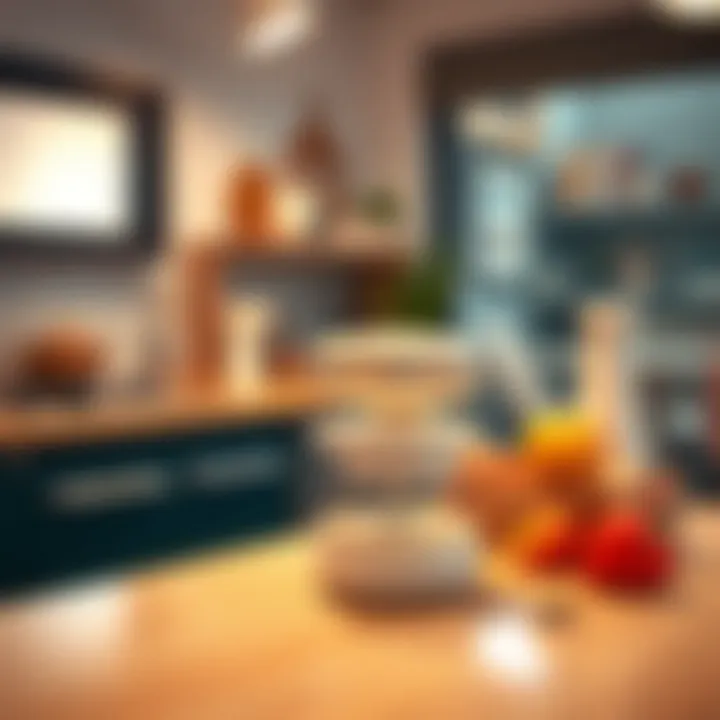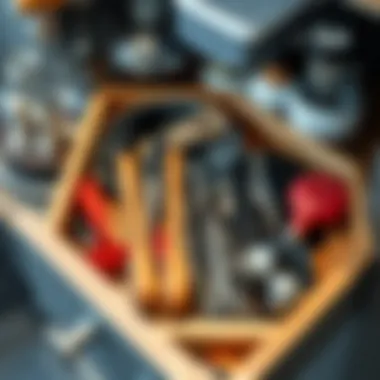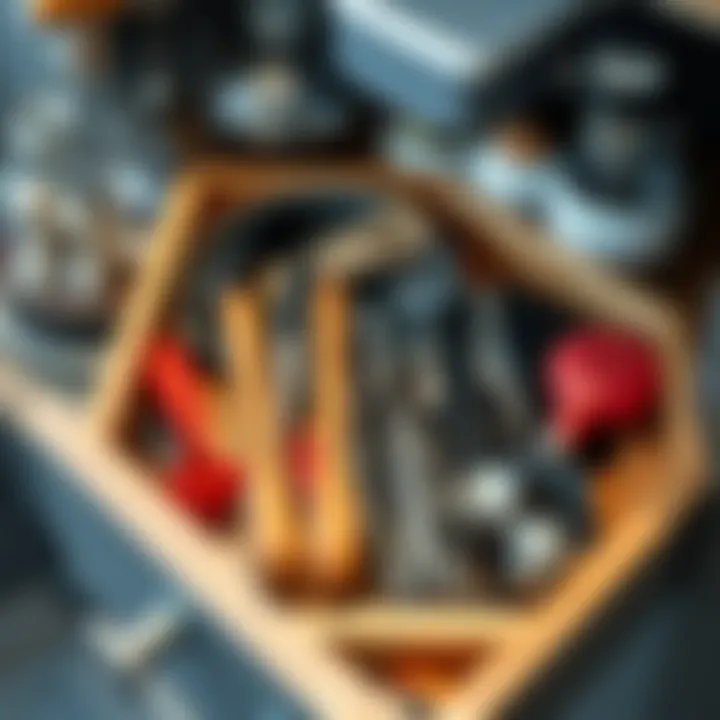Exploring the World of Kitchen Gadgets for Modern Homes


Intro
The landscape of kitchen gadgets is vast and ever-changing, evolving beyond mere functionality into a blend of art and utility. Whether you’re a seasoned chef or a novice in the culinary world, the right tools can make all the difference in your cooking experience. This article provides an in-depth exploration of kitchen gadgets, their historical context, how they influence our cooking styles, and ways to select the right tools that strike a balance between beauty and practicality.
Today, the array of kitchen gadgets available can be overwhelming. With everything from smart appliances to simple hand tools, it becomes crucial for a homeowner or designer to distinguish the essential from the superfluous. The modern kitchen not only serves as a place for meal preparation but also stands as a statement of personal style and innovation. This article will weave through various aspects, focusing on the intersection of functionality and aesthetics.
As we navigate these insights, it will empower you to make wise decisions when adding to your kitchen collection, thereby enhancing both your culinary adventures and your kitchen's decor.
Furniture Design Trends
Current Styles and Themes
When we look at kitchen gadgets within the broader context of kitchen design, we can see how trends manifest in the tools we choose. Minimalist designs are all the rage today, focusing on simplicity and elegance. Items like sleek stainless-steel knives, clear acrylic containers, and multifunctional devices are finding their way into homes. They not only perform various tasks but also provide a streamlined look.
Conversely, vintage and retro styles have made a comeback. Think of hand-cranked egg beaters or classic cast-iron skillets. These tools carry with them not just functionality but also rich stories and nostalgia, appealing to a wide audience. The aesthetic value is undeniable, often prompting homeowners to display them as part of their kitchen decor, creating a warm and inviting atmosphere.
Color Palettes and Materials
In today’s kitchens, color palettes play an essential role in gadget selection. Colors like matte black, soft pastels, and vibrant hues are popular, often reflecting personal taste and complementing cabinetry and countertops. The choice of materials also speaks volumes. Silicone has gained traction for its flexibility and ease of cleaning, while wood adds a classic touch of warmth.
Moreover, combining materials, such as a wooden cheese board with stainless-steel graters, suggests a harmonious blend of old and new, creating a more inviting and engaging cooking environment.
"Having the right kitchen tools is not just about function, but the joy they bring to the cooking experience."
Practical Furniture Tips
How to Choose the Right Size
Selection needs to be mindful not just of aesthetics, but also size. A compact kitchen might not accommodate bulky gadgets, so durability and compact design are key. When evaluating tools like food processors or blenders, think about the frequency of use and storage options. Look for gadgets that can nest together or serve multiple purposes efficiently.
Maintenance and Care for Longevity
Once you've invested in quality gadgets, proper care becomes essential. Regular cleaning, skillful handling, and following manufacturer guidelines extend the lives of these tools. For instance, wooden utensils require oiling to prevent drying out, while stainless steel tools need regular polish to maintain shine. Understanding how to preserve the integrity of these items is crucial, ensuring they remain a part of your kitchen for years to come.
In sum, as we dissect the elements of kitchen gadgets, from trends to practical advice, this comprehensive guide serves as a roadmap for those looking to enhance their culinary toolkit with both function and flair. With the right information at hand, you’re well on your way to a stylish yet practical kitchen experience.
Understanding Kitchen Gadgets
Kitchen gadgets are more than just an assortment of tools; they serve as essentials for modern culinary arenas. Understanding kitchen gadgets can empower both seasoned chefs and novice home cooks—a key point this article seeks to address. With a plethora of options available, distinguishing between various functionalities and purposes helps in making informed decisions. The right gadgets simplify cooking processes, making them faster and more efficient. Additionally, these tools often spark creativity, encouraging the exploration of diverse culinary techniques.
Definition and Scope
Kitchen gadgets refer to a wide range of hand-held or electric tools designed to assist with cooking, food preparation, and storage. They can be as simple as a can opener or as sophisticated as a smart kitchen appliance. The scope of kitchen gadgets extends beyond functionality; it encompasses design and usability as well.
Common definitions include items specifically engineered for food tasks—these could be measuring cups, peelers, blenders or even advanced technological devices in the culinary world. Understanding this scope allows for a clearer perspective on what tools are truly valuable in the kitchen.
Historical Evolution
From Basic Tools to Advanced Technology
The history of kitchen gadgets stretches far back, evolving from basic stone tools to advanced devices we use today. In ancient times, simple knives and grinding stones were the mainstay tools for food preparation. Over the centuries, innovation led to significant advancements, with tools becoming more specialized and crafted from varying materials, like wood, metal, or plastic.
Today, we have gadgets like food processors or sous-vide cookers which would have astounded our ancestors. These modern tools significantly enhance cooking capabilities, allowing for precision and efficiency in ways unimaginable before. This transition reflects both technological advancements and an improving understanding of food science. Most importantly, these gadgets are designed for ease in cooking processes. However, a concern remains about excessive dependency—can one over-rely on technology while losing basic cooking skills?
Influence of Culinary Trends
In the realm of kitchen gadgets, culinary trends play a significant role in shaping what tools gain popularity. For instance, the surge in interest towards healthier eating and organic cooking has led to the rise of gadgets like spiralizers or avocado slicers. These items cater to consumer demand for both convenience and fresh ingredients.
Interestingly, trends also create room for novel gadgets that address specific needs, while also phasing out older tools. However, while chasing trends, it is important to consider the practicalities of such gadgets. Are these items genuinely useful or just passing fads? Assessing the longevity and utility of these gadgets is key to creating a sustainable kitchen. Ultimately, the influence of culinary trends allows us to connect our cooking habits with new innovations—it is essential to stay informed.
"Kitchen gadgets are not only tools; they are reflections of our evolving culinary culture."
Categories of Kitchen Gadgets
Understanding the various categories of kitchen gadgets is crucial for both novice cooks and seasoned chefs alike. With an array of options at one's disposal, knowing which tools serve specific purposes can greatly enhance the culinary experience. It widens the scope for creativity in cooking, helps to save time, and ensures that the kitchen remains organized. More than just tools, these gadgets have the power to transform the cooking process into an art form, making meal preparation not only effective but also enjoyable.
Preparation Tools
Preparation tools are the unsung heroes of any kitchen, setting the stage for a smooth cooking session. They are foundational for chefs of all skill levels, whether whipping up a quick breakfast or preparing a gourmet meal for guests.
Cutting Instruments
Cutting instruments encompass a variety of tools that are essential for preparing ingredients. Knives, peelers, and slicers all fall under this category. A key characteristic of cutting instruments is their ability to provide precision and efficiency. A sharp chef's knife, for instance, can make quick work of chopping herbs or dicing vegetables, which is critical for reducing prep time. One unique feature is the variety of blade types available, each designed for specific tasks, such as a serrated knife for bread or a paring knife for intricate detailing.
The primary advantage here lies in the enhanced control over food prep, allowing for not just speed but also uniformity in ingredient size, which is important for even cooking. On the flip side, improper handling or care can lead to injuries or dull blades, hence requiring users to engage with these instruments mindfully.


Measuring Tools
Measuring tools, including cups and digital scales, are vital in ensuring accuracy in recipes. The key characteristic of these tools is their emphasis on precision, making them a favorite among bakers and chefs who seek consistency in their culinary creations. For example, a digital kitchen scale can minimize discrepancies in ingredient amounts, leading to more reliable results.
One notable feature of modern measuring tools is the ease of use they provide. Many digital models come with conversion settings, allowing for easy adjustments from standard to metric measurements. However, a disadvantage may arise when users depend solely on their devices, potentially developing less intuitive cooking skills over time.
Cooking Gadgets
Cooking gadgets are designed to elevate the cooking process, often through innovation and technology. This category encompasses everything from appliances to advanced cookware, offering solutions for a plethora of culinary techniques.
Appliances
When one thinks of appliances, they think of items like blenders, slow cookers, and microwaves. The strength of these gadgets lies in their versatility and ability to cater to a range of cooking styles. For instance, an air fryer can replicate the effect of deep-frying with significantly less oil, making it a popular choice for health-conscious cooks.
A unique feature of modern cooking appliances is their connectivity; many are now smart devices that can be controlled via smartphone apps, offering convenience in meal preparation. Still, reliance on gadgets can sometimes stifle creativity, as the allure of convenience may lead some to rely on appliance settings rather than their own culinary instincts.
Cookware Innovations
Cookware innovations focus on enhancing the cooking experience, with items such as non-stick frying pans, ceramic bakeware, and high-tech pressure cookers coming to mind. Their major draw is that they provide ease of use and extraordinary cooking results, with non-stick surfaces making it simpler to clean up after meals.
What's particularly gainsay about contemporary cookware is the eco-friendly options available, such as sustainable materials that resist scratches and wear. On the downside, some high-tech cookware can be pricey, which may discourage some from investing in top-tier products.
Storage Solutions
Storage solutions play a pivotal role in maintaining an organized and efficient kitchen. By keeping tools and ingredients well-organized, cooks can focus on the art of preparation without being distracted by clutter.
Organizational Tools
Organizational tools include racks, bins, and drawer organizers that help keep a kitchen tidy. Their standout feature is their ability to maximize space, making even the smallest kitchens more functional. A well-designed spice rack or utensil drawer can make a world of difference for a home cook navigating through busy meal prep.
While the advantages are numerous, including reduced stress and time spent searching for tools, it's essential to choose organizers that fit both the kitchen design and the specific needs of the cook.
Preservation Gadgets
Preservation gadgets, such as vacuum sealers and food storage containers, serve to extend the life of foods and maintain flavors. A crucial aspect of these tools is their role in decreasing waste, ultimately contributing to sustainability efforts in the kitchen.
A unique feature is the ability of vacuum sealers to lock out air, thus preserving the freshness of ingredients for longer. However, their initial costs might be a deterrent for some, though the long-term savings from reduced food waste can quickly justify the investment.
The various categories of kitchen gadgets present a spectrum of options that cater to diverse culinary needs. From preparation tools that set the foundation to cooking gadgets that spark creativity, and storage solutions that maintain order, these gadgets collectively enrich the kitchen experience, allowing for both efficiency and artistry.
Functional Aspects of Kitchen Gadgets
Kitchen gadgets are not simply accessories that clutter the countertop; they serve crucial roles in improving how we cook and prepare food. This section digs into how these tools amplify efficiency while nurturing culinary creativity. Understanding their functional aspects is key for anyone wanting to make thoughtful choices in their kitchen.
Enhancing Efficiency
Efficiency in the kitchen can make or break the cooking experience. When you’re whipping up a meal, every minute counts, especially on a busy weekday. Gadgets that streamline cooking tasks become invaluable tools in creating a smooth workflow.
Time-Saving Features
Time-saving features in kitchen gadgets are designed with one goal in mind: allowing cooks to accomplish more in less time. High-speed blenders, for instance, cut prep time by quickly turning whole fruits and vegetables into smoothies. A notable example is the Vitamix blender, which takes ingredients from whole to perfectly blended within seconds.
Moreover, gadgets like food processors can chop, slice, and dice at lightning speed, effectively replacing the need for manual knife work. This not only saves time but also eliminates the risk of knife injuries and ensures uniformity in food preparation.
But while time-savers are highly favored, they come with their own set of challenges. Sometimes, reliance on gadgets can lead to a decline in fundamental cooking skills. It's crucial to strike a balance between gadget use and traditional techniques to enhance one’s culinary repertoire.
Ease of Use
Ease of use is another essential characteristic of kitchen gadgets, directly affecting the overall cooking experience. A gadget that complicates tasks rather than simplifying them runs the risk of collecting dust in the cupboard. Take the example of instant pots: these multifunctional tools are user-friendly and combine multiple cooking methods into one appliance, making them particularly appealing to home cooks.
Additionally, intuitive controls and easy-to-read displays allow even novice cooks to navigate these technologies without frustration. However, some gadgets, especially those with an overwhelming number of options, can lead to confusion. Finding tools that prioritize straightforward operation will help ensure that cooking remains a rewarding endeavor.
Improving Culinary Creativity
A functional kitchen is not merely about getting the meals done; it also involves inspiring creativity and innovation in cooking. Kitchen gadgets can be excellent catalysts, pushing cooks to try new techniques and flavors.
Exploration of New Techniques
Exploration of new techniques through the use of gadgets invites cooks to experiment. Sous-vide machines, for instance, have rekindled interest in precise cooking methods among enthusiasts and professionals alike. The ability to cook food in a temperature-controlled water bath opens avenues for achieving textures and flavors that traditional methods may not provide.
Such innovations encourage culinary exploration, making it easier to replicate dishes that require elaborate techniques like slow roasting or precise temperature control. However, while learning new techniques can be exciting, there is a risk of becoming too reliant on gadgets. Cooks must ensure they develop their cooking abilities alongside adopting new tools, maintaining authenticity in their culinary style.
Encouragement of Experimentation
When kitchen gadgets promote experimentation, they foster an environment where cooks feel at liberty to try unconventional methods. Air fryers are a prime example; they allow individuals to prepare healthier versions of fried foods, making it easy to experiment while still maintaining taste.


This freedom to experiment fuels creativity in the kitchen, potentially leading to the discovery of unique flavor combinations. Nonetheless, embracing uncertainty can lead to failures, and not every experiment will yield a palatable dish. Accepting this aspect is part of the growth as a cook.
Ultimately, kitchen gadgets serve to elevate both efficiency and creativity, fostering a space where cooking transforms from a chore into an engaging and rewarding experience.
Overall, the functional aspects of kitchen gadgets contribute significantly to the modern culinary landscape, creating opportunities and pathways for enhanced cooking experiences.
Aesthetic Considerations
The importance of aesthetics in kitchen gadgets can't be overstated. Kitchen gadgets serve a practical purpose, but their visual appeal plays a significant role in the overall kitchen environment. Integrating aesthetics can lead to a more inviting and cohesive culinary space. As kitchens have become essential family gathering spots, choosing gadgets that please the eye has become just as important as selecting tools that perform well. A well-designed gadget may inspire creativity and foster an atmosphere where culinary magic can happen.
Design Trends in Kitchen Gadgets
Minimalism in Kitchen Tools
Minimalism has become a defining trend in kitchen gadgets, shaping how we perceive functionality and design. The appeal of minimalist tools lies in their simplicity and effectiveness. They tend to feature clean lines, neutral colors, and ergonomic shapes, promoting ease of use. For instance, a simple wooden cutting board or a stainless-steel whisk can enhance the cooking experience without overwhelming the space.
The key characteristic of minimalism is its focus on what’s essential, removing any unnecessary embellishments that distract from the task at hand. This approach encourages focus on the preparation and enjoyment of food, rather than the clutter that can often get in the way. By embracing this style, one can create a kitchen that balances productivity with tranquility.
However, it's worth noting some challenges with minimalist tools. Because of their subdued designs, they might not stand out in a kitchen full of vibrant colors, potentially losing visual interest in the overall décor.
Color and Material Choices
Color and material choices in kitchen gadgets have a significant effect on the room's ambiance. The material of a gadget—be it ceramic, wood, or metal—can accentuate the overall kitchen theme, contributing to a seamless aesthetic experience.
For example, bamboo utensils are not just functional; they bring a warm, natural touch to the kitchen. In contrast, sleek stainless steel exudes a modern and sophisticated vibe. Brightly colored gadgets can serve as statement pieces, breaking the monotony of more neutral palettes. Many homeowners find this attribute beneficial as it allows them to express personal taste while keeping functionality at the forefront.
The unique feature of color and material choices is their adaptability. Whether you prefer a rustic, farmhouse feel or a sleek minimalist design, you can find gadgets that fit the bill. However, be cautious with highly decorative items. Sometimes they can sacrifice practicality for aesthetics, which can lead to frustration in culinary tasks.
Integration with Kitchen Decor
Creating a Cohesive Space
Creating a cohesive space involves connecting the kitchen’s function with its aesthetics. When gadgets blend seamlessly with cabinetry, countertops, and overall décor, they contribute to a unified atmosphere. High-quality materials and thoughtful designs can elevate the kitchen, making it more appealing and user-friendly.
The unique feature here is how well-chosen gadgets can balance between function and style, enhancing not only the workspace but also the daily experience of cooking and entertaining. It is common to see tools that are thoughtfully positioned, adding to the kitchen décor rather than detracting from it. Cohesiveness also reinforces the kitchen’s role as a central space in the home.
However, a challenge may arise when gaps exist between the aesthetic intentions and the gadgets' practicality. Choosing something that looks amazing might not always serve the best functional purpose, and aiming for cohesion can sometimes limit your choice of tools.
Incorporating Stylish Gadgets
Incorporating stylish gadgets into the kitchen can significantly impact the overall character of the space. These pieces often serve dual purposes—functionality and decoration. A well-chosen, eye-catching blender or a uniquely shaped serving dish can become focal points in your kitchen that draw attention—but not in a cluttered way.
Stylish gadgets often adhere to the latest trends, allowing homeowners to stay current with tastes that prioritize both creativity and individuality. They can enhance the cooking experience by providing excitement in the tools being used. Its key characteristic is the blend of style with practicality, often making cooking enjoyable and aesthetically pleasing.
Yet, the downside to consider is the price. Stylish gadgets can sometimes come with a hefty price tag, which not every homeowner may be willing to pay. Additionally, some may choose style over functionality, which could hinder the intended culinary tasks.
In summary, aesthetic considerations in kitchen gadgets bridge the gap between functionality and enjoyment. They enrich the cooking environment, promoting a visually stimulating and cohesive culinary journey.
Guidelines for Choosing Kitchen Gadgets
When stepping into the world of kitchen gadgets, choices abound. This section provides a compass to navigate through the multitude of options and assist in making informed decisions. Focusing on individual needs and discerning quality from price are crucial. These guiding principles help optimize your culinary space and ultimately elevate your cooking experience. Selecting the right gadgets can save you time and frustration, enabling you to focus on what truly matters: creating delicious meals.
Assessment of Needs
Understanding one’s cooking habits is a vital starting point. This helps in determining which gadgets can become invaluable allies in the kitchen.
Identifying Cooking Habits
Identifying Cooking Habits is like taking a pulse of your culinary practices. Knowing how often you cook, what types of meals you enjoy preparing, and whether you prefer quick dinners or elaborate feasts guides you in selecting suitable gadgets. If you frequently whip up gourmet meals, a high-quality food processor might be a must-have. Conversely, if you're a casual cook, simpler tools may suffice.
The primary characteristic here is that this process allows for customization of your kitchen gadget collection. It’s smart to assess trends in your cooking - do you lean towards baking or grilling? By doing this, you’ll not only save money but also avoid cluttering your kitchen with gadgets that would mostly gather dust. However, one needs to be mindful: over-emphasizing fancy tools can sometimes overshadow basic techniques, which are just as important.
Determining Space Limitations
Next, we have Determining Space Limitations, which is crucial for any kitchen setup. Assessing how much room you have is vital when considering your gadget selection. A cramped kitchen can quickly become a cluttered and overwhelming space, so what you choose to add must thoughtfully reflect available space.
This involves measuring cabinet space, counter areas, and storage options. The key characteristic here is practicality. For instance, appliances that nest or fold can save significant space. Additionally, some gadgets may be multifunctional, such as a blender that can also knead dough, providing versatility without hogging valuable real estate on your countertops.
One potential pitfall is ignoring the layout of your kitchen entirely. Placing high-use items out of reach or blocking essential counter space may lead to frustration. Finding the balance between function and aesthetics is key.
Quality vs. Price
Now, onto the all-important discussion of Quality vs. Price. With so many options available, understanding how these two factors interact can greatly influence your choices.
Understanding Value


Understanding Value is paramount when selecting kitchen gadgets. It’s not purely about the price tag; instead, it’s about identifying what you get for your money. A pricier gadget might seem intimidating at first glance, yet it may offer features or longevity that cheaper alternatives lack. For instance, a high-quality chef's knife can last for years, providing superior performance, while a cheap knife could require frequent replacement, leading to greater long-term costs.
This characteristic encourages consumers to evaluate the long-term gains versus immediate expenses. It also promotes smarter investments in tools that enhance your culinary experience, making cooking a joy rather than a chore.
Longevity and Durability
Finally, we address Longevity and Durability. This element directly impacts your satisfaction and usability of kitchen gadgets over time. A robust kitchen appliance that withstands regular use is essential for any serious cook.
The hallmark of durability is often tied to the materials used; for example, stainless steel items tend to resist warping and corrosion better than plastic ones. Though they may come with a slightly higher initial cost, durable tools tend to repay that investment by functioning well for years.
A unique feature of highly durable items is the ability to undertake rigorous tasks without breaking down. However, one must be cautious not to confuse durability with cumbersome design; some gadgets might be tough but could be heavy or unwieldy in day-to-day use.
Sustainable Kitchen Gadget Practices
In today's world, the emphasis on sustainability resonates louder than ever. This focus plays a crucial role in the kitchen lifestyle, extending to the very tools we utilize for our culinary endeavors. As conscious consumers, we look for gadgets that not only enhance our cooking experience but also protect the environment. Embracing sustainable practices in the selection and use of kitchen gadgets can lead to significant environmental benefits, proving that even small choices can have a large impact.
Choosing Eco-Friendly Options
Materials and Manufacturing Processes
When it comes to kitchen gadgets, the materials used in their creation are not merely insignificant details; they tell a substantial story. Opting for eco-friendly materials—like bamboo, stainless steel, or recycled plastics—can drastically reduce the environmental footprint of our kitchens. Bamboo, for instance, is not just aesthetically pleasing but also a rapidly renewable resource. The lightweight strength it offers is a fantastic characteristic making it popular in various kitchen items. Its unique feature of natural antimicrobial properties adds yet another reason to opt for bamboo over conventional plastics.
Still, not all eco-friendly materials are without challenges. Some may not stand up to wear and tear as effectively as their plastic counterparts. By understanding these nuances, we equip ourselves to make truly informed choices.
Energy-Efficient Appliances
Energy-efficient appliances are more than just buzzwords; they represent a shift towards smarter consumption in the kitchen. These gadgets are designed to consume less energy while still performing optimally. For example, an energy-efficient blender uses advanced technology to blend ingredients thoroughly without the high electricity costs of standard models.
The unique feature of these appliances is their ability to significantly reduce our electricity bills while minimizing environmental harm. Still, their initial cost can sometimes be a hurdle. However, the long-term savings usually outweigh the upfront investment, reinforcing the importance of adopting such devices in a modern kitchen.
Reducing Waste
Multi-Functional Gadgets
In a times where being resourceful is a must, multi-functional gadgets stand out. These clever tools simplify cooking processes by combining functions that would usually require multiple devices. A spiralizer that also acts as a veggie chopper is an excellent example. Not only does this save space, but it also cuts down on waste—who hasn’t found themselves with a drawerful of rarely used appliances?
Their growing popularity stems from their ability to streamline kitchen activity while being mindful of clutter. However, one must be cautious; multi-functional gadgets can sometimes lead to compromises in performance for specific tasks, thereby requiring careful consideration before purchase.
Longevity and Reusability
Another eco-friendly consideration is the longevity and reusability of kitchen gadgets. Investing in durable tools that can withstand daily use is the key characteristic of this approach. For instance, glass storage containers are a more sustainable choice than single-use plastic bags, lasting years and reducing overall waste.
Moreover, employing reusable items like cloth wraps or silicone lids helps cut down on disposable products, promoting a sustainable kitchen culture. However, not every reusable item is suited for every task, which may pose challenges in areas of convenience and availability, yet focusing on durability fosters a healthier, cleaner environment.
"Every gadget chosen can reflect a commitment to sustainability, enhancing our cooking practices while caring for the planet."
Through incorporating these sustainable practices, we contribute not just to our kitchens but also to the larger ecological narrative. As homeowners, designers, and DIY enthusiasts, the choices we make today will echo in the culinary landscapes of tomorrow.
Future of Kitchen Gadgets
As we peer into the future of kitchen gadgets, it becomes clear that their evolution is intertwined with technological advancements and shifting consumer expectations. The intersection of convenience and innovation shapes the way we cook, entertain, and even understand food. This section unpacks the currents influencing these changes, focusing on two major aspects: technological innovations and potential trends that will redefine the kitchen layout and functionality.
Technological Innovations
Smart Kitchen Devices
The advent of smart kitchen devices marks a revolutionary shift in how we engage with our culinary spaces. At the heart of these devices lies their ability to connect to the internet, allowing users to control and monitor their cooking processes remotely. For instance, consider a smart oven that can be pre-heated from your smartphone while you are out shopping for groceries. This key characteristic not only saves time but ensures that meal prep fits seamlessly into your busy lifestyle, an attribute that aligns with our fast-paced society.
One standout feature of these devices is their ability to learn from user habits, automatically suggesting recipes based on previous cooking choices. While this capability adds convenience, one should also weigh the disadvantages: reliance on technology can create a barrier in mastering fundamental cooking skills. These gadgets cater to tech-savvy home chefs, but they demand a comfort level with digital interfaces that not everyone possesses.
Integration with Home Automation
The integration of kitchen gadgets within broader home automation systems signifies a leap forward in holistic living environments. The key characteristic here is the interoperability of devices that communicate seamlessly, adjusting the lighting or playing music while you prepare a meal. This convenience makes it a preferred choice for those looking to create a multisensory cooking experience.
However, the added complexity can be a double-edged sword. Setting up these interconnected systems may overwhelm some users, particularly those less familiar with smart technology. The unique feature, such as voice control integration, allows for hands-free operation—an appealing prospect for busy cooks. Although the integration streamlines kitchen processes, it also raises issues surrounding privacy and data security, which demand careful consideration.
Potential Trends
Sustainability Trends
Sustainability is no longer a passing trend; it is becoming a core principle in kitchen gadget design. As environmental consciousness grows, many consumers are gravitatiing towards gadgets that prioritize eco-friendly materials and energy efficiency. This key characteristic is beneficial for both the environment and those looking to reduce their carbon footprint.
One notable example is the emergence of gadgets that minimize energy consumption while maintaining high performance levels. A prominent downside, however, is the often higher upfront cost of such sustainable products. Nevertheless, the long-term savings on energy bills make them a smart investment, resonating with a more informed consumer base eager to combine functionality with environmental stewardship.
Personalization in Kitchen Design
The shift towards personalization reflects a growing desire among homeowners to create kitchens that not only meet practical needs but also resonate with individual style preferences. This key characteristic allows users to choose gadgets tailored to their personal aesthetics, enhancing the overall cooking environment. Customizable color options and unique designs are ideal for those who want their kitchen to make a statement.
Nevertheless, while personalization leads to a more inviting space, it can lead to decision paralysis for some individuals who may feel overwhelmed by choice. This trend highlights a crucial aspect: striking a balance between functionality and decor. As kitchen gadgets become more versatile, they're not just units of utility but expressions of identity in the culinary realm, representing a fusion of practicality and personal taste.
"In the future, kitchen gadgets will not just serve functional roles; they’ll become integral pieces of our daily lives, blending seamlessly with our homes and lifestyles."
With all these changes on the horizon, keeping up-to-date with the future of kitchen gadgets is essential for anyone looking to enhance their cooking experience and elevate their culinary spaces. As technology and design continue to evolve, so too will our relationship with the instruments we use to create our meals.



